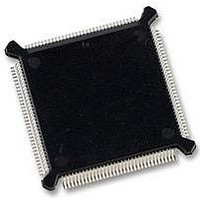MC68331CEH25 Freescale Semiconductor, MC68331CEH25 Datasheet - Page 128

MC68331CEH25
Manufacturer Part Number
MC68331CEH25
Description
IC MCU 32BIT 25MHZ 132-PQFP
Manufacturer
Freescale Semiconductor
Series
M683xxr
Specifications of MC68331CEH25
Core Processor
CPU32
Core Size
32-Bit
Speed
25MHz
Connectivity
EBI/EMI, SCI, SPI, UART/USART
Peripherals
POR, PWM, WDT
Number Of I /o
18
Program Memory Type
ROMless
Voltage - Supply (vcc/vdd)
4.5 V ~ 5.5 V
Oscillator Type
Internal
Operating Temperature
-40°C ~ 85°C
Package / Case
132-QFP
Controller Family/series
68K
No. Of I/o's
18
Cpu Speed
25MHz
No. Of Timers
1
Embedded Interface Type
QSPI, SCI, UART
No. Of Pwm Channels
2
Digital Ic Case Style
PQFP
Rohs Compliant
Yes
Processor Series
M683xx
Core
CPU32
Data Bus Width
32 bit
Data Ram Size
80 B
Interface Type
QSPI, SCI, UART
Maximum Clock Frequency
25 MHz
Number Of Programmable I/os
18
Number Of Timers
1
Maximum Operating Temperature
+ 85 C
Mounting Style
SMD/SMT
Minimum Operating Temperature
- 40 C
Eeprom Size
-
Ram Size
-
Program Memory Size
-
Data Converters
-
Lead Free Status / Rohs Status
Details
Available stocks
Company
Part Number
Manufacturer
Quantity
Price
Company:
Part Number:
MC68331CEH25
Manufacturer:
PANASONIC
Quantity:
2 000
Company:
Part Number:
MC68331CEH25
Manufacturer:
Freescale Semiconductor
Quantity:
135
Company:
Part Number:
MC68331CEH25
Manufacturer:
Freescale Semiconductor
Quantity:
10 000
6
6.2 QSM Registers and Address Map
6.2.1 QSM Global Registers
6.2.1.1 Low-Power Stop Operation
6-2
The SCI provides a standard nonreturn to zero (NRZ) mark/space format. It will oper-
ate in either full- or half-duplex mode. There are separate transmitter and receiver en-
able bits and dual data buffers. A modulus-type baud rate generator provides rates
from 64 to 524 kbaud with a 16.78-MHz system clock, or 110 to 655 kbaud with a
20.97-MHz system clock. Word length of either eight or nine bits can be selected. Op-
tional parity generation and detection provide either even or odd parity check capabil-
ity. Advanced error detection circuitry catches glitches of up to 1/16 of a bit time in
duration. Wakeup functions allow the CPU to run uninterrupted until meaningful data
is available.
There are four types of QSM registers: QSM global registers, QSM pin control regis-
ters, QSPI registers, and SCI registers. Global registers and pin control registers are
discussed in 6.2.1 QSM Global Registers and 6.2.2 QSM Pin Control Registers.
QSPI and SCI registers are discussed in 6.3 Queued Serial Peripheral Interface and
6.4 Serial Communication Interface. Writes to unimplemented register bits have no
meaning or effect, and reads from unimplemented bits always return a logic zero val-
ue.
The QSM address map includes the QSM registers and the QSPI RAM. The module
mapping (MM) bit in the SIM configuration register (SIMCR) defines the most signifi-
cant bit (ADDR23) of the IMB address for each module in the MCU.
Refer to APPENDIX D REGISTER SUMMARY for a QSM address map and register
bit/field definitions. SECTION 4 SYSTEM INTEGRATION MODULE contains more in-
formation about how the state of MM affects the system.
The QSM configuration register (QSMCR) contains parameters for interfacing to the
CPU32 and the intermodule bus. The QSM test register (QTEST) is used during fac-
tory test of the QSM. The QSM interrupt level register (QILR) interrupt level register
(QILR) determines the priority of interrupts requested by the QSM and the vector used
when an interrupt is acknowledged. The QSM interrupt vector register (QIVR) interrupt
vector register (QIVR) contains the interrupt vector for both QSM submodules. QILR
and QIVR are 8-bit registers located at the same word address. Refer to APPENDIX
D REGISTER SUMMARY for register bit and field definitions.
When the STOP bit in the QSMCR is set, the system clock input to the QSM is disabled
and the module enters a low-power operating state. QSMCR is the only register guar-
anteed to be readable while STOP is asserted. The QSPI RAM is not readable, but
writes to RAM or any register are guaranteed valid while STOP is asserted. STOP can
be set by the CPU and by reset.
System software must stop the QSPI and SCI before asserting STOP to prevent data
corruption and simplify restart. Disable both SCI receiver and transmitter after trans-
fers in progress are complete. Halt the QSPI by setting the HALT bit in SPCR3 and
Freescale Semiconductor, Inc.
For More Information On This Product,
QUEUED SERIAL MODULE
Go to: www.freescale.com
USER’S MANUAL
MC68331











